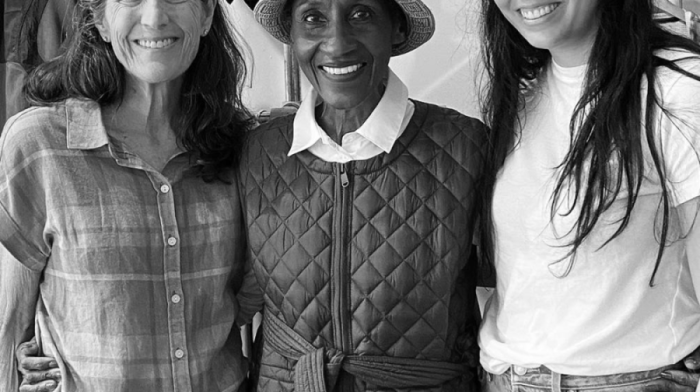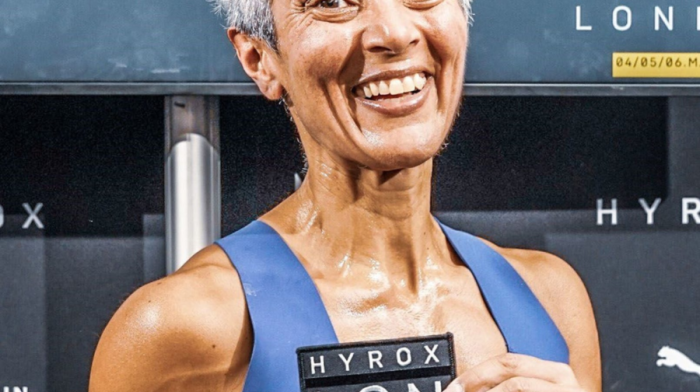Growing up, I always struggled with my weight. Once I hit puberty, I gained even more weight and developed curves. I was self-conscious about my appearance, but I tried to overcompensate with my personality and accomplishments. I didn’t want anyone to know I struggled.
As my weight continued to creep up, I developed disordered eating tendencies in high school. It was a silent struggle, because I didn’t want others to think I wasn’t confident, but I tried every quick-fix weight loss trick and fad diet under the sun. I completed two rounds of the Whole30, attempted to go vegetarian, and became obsessed with the paleo diet. I wouldn't even look at bread and didn’t have a potato for over three years. At one point, I lost 25 pounds on the paleo diet, but it wasn’t sustainable. I was extremely restrictive and as soon as I stopped the diet, the weight immediately came back.
I wasn’t confident going into a traditional gym, but I was also never sedentary. I was a dancer until I graduated high school, and I trained service dogs, which is a very active sport. It didn’t seem to matter how active I was, though, because my weight never budged. So, the diet cycle continued.
But in July 2019, at 36 years old, I started experiencing strange health symptoms.
I woke up in the middle of the night with an excruciating headache. Previously, I had never suffered from migraines, but it was the most severe pain I had ever felt in my life. The pain eventually dissipated, but I knew something was seriously wrong. At the time, I worked at an ophthalmology hospital, so I saw an ocular specialist the next day, but they immediately referred me to a neurosurgeon.
I continued having unbearable headaches that would seemingly come out of nowhere, and after countless tests and doctors’ visits, I was finally diagnosed with idiopathic intracranial hypertension. It’s a rare condition that primarily affects women of childbearing age and happens when there is too much cerebrospinal fluid in the skull. This then causes increased pressure on the brain and optic nerve, which triggers tremendous headache, eye pain, and in some cases, blindness.
There’s no cure for the condition, which left me frustrated and hopeless.
Doctors told me there were three treatment options: brain surgery, a strong diuretic medication, and weight loss.
Experts have found that weight loss can help alleviate symptoms. Brain surgery didn’t feel like a realistic option, so I tried medication first. Unfortunately, the headaches persisted, and I was in such severe pain I missed tons of work and constantly threw up from the discomfort.
The condition also causes swelling in the body due to the build-up of fluid, and working out made my head feel like it was going to explode. As a result, I gained more weight, which only made things worse. I was physically in a lot of pain and my mental health took a serious toll. I thought I was going to suffer forever.
It wasn’t until I posted about my diagnosis on Facebook that a mutual friend messaged me and shared that her daughter had the same condition and was relieved of symptoms after she had bariatric surgery. I had never even thought of bariatric surgery as a possibility, and none of my neurosurgeons recommended it as a weight loss tool, but I was immediately intrigued.
I researched weight loss surgery for the next few months. I felt like I needed to do my due diligence, and I wanted to explore all of my options. I’m typically an indecisive, introverted person, but my life was on the line, and if weight loss surgery could cure my pain, I was all-in. My husband was also on-board, and we knew this could be life-changing, so I wanted to give it a shot. At my heaviest, I was 260 pounds.
This type of surgery combines a sleeve gastrectomy with an intestinal bypass. The duodenal switch is the most complicated type of bariatric surgery, but it’s also the most effective, per Cleveland Clinic.
It was my first time under anesthesia, so I was extremely nervous. I cried my way to surgery, but I also knew I couldn’t live with the unbearable headaches much longer, so I was optimistically hopeful.
During the procedure, doctors essentially removed part of my stomach with an intestinal bypass, which makes the path food takes through my intestines shorter. The surgery is minimally invasive, but the goal is to restrict how much food my stomach could hold, ultimately decreasing my overall appetite.
Thankfully, the surgery went beautifully. I thought I would be in a lot of physical pain, or at least feel some sort of emptiness inside, but overall, I felt really good. I had five small incisions, so there was some pressure at the incision sites, but my pain was easily controlled and I was up walking shortly after surgery.
For the first two weeks post-surgery, I had to stick to an all-liquid diet while my stomach adjusted and healed.
I also couldn’t have anything too hot or too cold, so I was left drinking room temperature protein shakes that had all the necessary nutrients I would need for the day. To be honest, this was tough. I wasn’t physically hungry, but I was mentally hungry. My brain thought I was starving and all I wanted was to taste real food. My whole life, I had turned to food for comfort, stress, and punishment, and not being able to eat solid food was extremely jarring.
I was also exhausted from the lack of calories, but walking is encouraged immediately after surgery, so I did laps around the house. After I built endurance, I progressed to walking around the neighborhood. Two weeks post-surgery, I was down 26 pounds.
Once I could transition back to a regular diet, I committed to meal prepping and counting macros. My goal was to hit 100 grams of protein a day, so Greek yogurt, tuna, grilled chicken, cheese, and eggs were my go-to, but I also focused on pairing every high-protein meal with fresh vegetables.
The gym still didn’t bring me joy after surgery, but I committed to staying active. I live near the beach, so I love kayaking, swimming, and taking long walks with my husband and dogs in the sand. The weight continued to fall off, and I steadily lost two to three pounds a week.
About two months after surgery, my headaches completely went away.
I was shocked, because I didn’t think it was possible, but I was symptom-free. I technically wasn’t “cured,” because I still have idiopathic intracranial hypertension, but I was no longer in debilitating pain. It took a few weeks for me to realize I was going to be okay, because the fear of a severe headache previously had such a stronghold over my life, but I felt like a totally new me. In a way, I got my life back.
On the one-year anniversary of my surgery, I was down 100 pounds. I also moved near the beach, so I embrace the outdoors and stay active by kayaking, swimming, and taking long walks with my husband and dogs in the sand. Today, more than four years later, I’ve lost a total of 125 pounds. My weight fluctuates a few pounds here or there, but that’s normal and I feel better than ever. I have more confidence than I thought was possible, and I’m living a happy, healthy life.
Weight loss is just one small piece of my story, but I can honestly say it saved my life. I still have the debilitating condition that didn’t allow me to live for over a year, but I’m so thankful I embarked on this journey. I’m forever grateful for the pain-free life I have today.





















Comments (0)